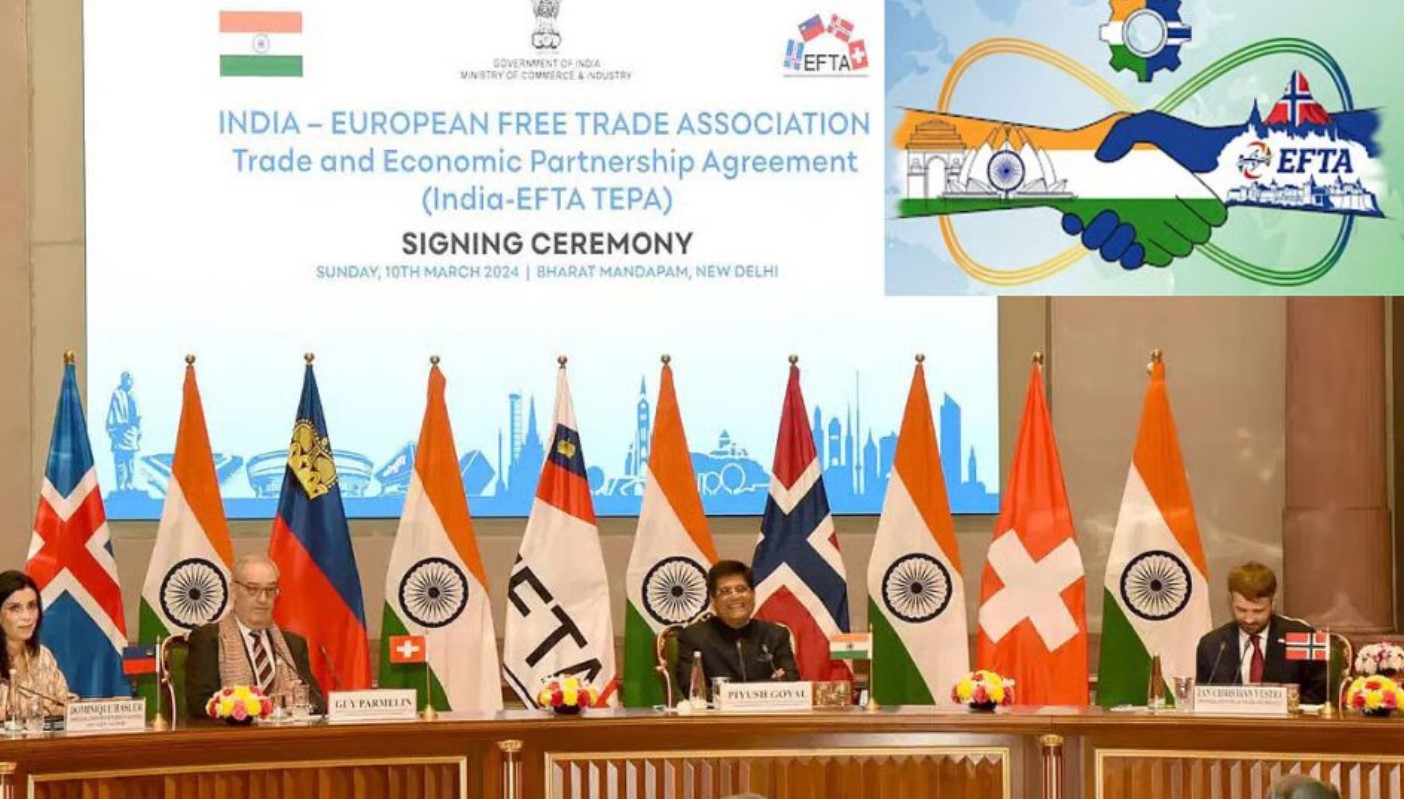India’s most ambitious trade pact yet came into effect today, promising cheaper Swiss watches and chocolates, but more importantly unlocking a record $100 billion investment commitment from Europe’s wealthy free trade bloc.
What TEPA Means for India and EFTA
The Trade and Economic Partnership Agreement (TEPA), signed on March 10, 2024, officially took effect on October 1. The deal links India with the European Free Trade Association (EFTA), a four-member group made up of Switzerland, Norway, Iceland, and Liechtenstein.
Unlike most trade pacts that focus mainly on tariff cuts, TEPA goes beyond goods. It carries a legally binding investment pledge of $100 billion over 15 years, a first in any Indian free trade agreement. Half of that is expected in the first decade, with the remainder to follow.
If this investment does not materialize, India holds the right to suspend tariff concessions, a safeguard that sets this deal apart from others.

Tariff Cuts on Swiss Goods
For consumers, TEPA will bring gradual duty cuts on luxury and industrial imports over the next ten years. Items like Swiss watches, chocolates, biscuits, clocks, wines, and premium apparel will become more affordable. Industrial imports such as precision machinery from Switzerland and medical devices from Norway will also face lower customs duties.
This is expected to reshape India’s retail and industrial markets, though experts say the bigger win lies in access to European capital and technology.
Export Openings for Indian Products
The pact is not a one-way street. Indian businesses now have improved access to high-income European markets for a wide range of products.
Textiles, leather goods, toys, marine products, and gems and jewelry are expected to gain a stronger foothold.
Agricultural exports like tea, coffee, and fruits will also enjoy preferential treatment.
High-tech items such as medical electronics, smart sensors, diagnostic devices, and electric vehicle components can tap into demand in Europe’s innovation-driven economies.
This opens new growth opportunities for India’s manufacturing sector, especially in labor-intensive industries that generate large-scale employment.
A Historic Investment Commitment
The $100 billion investment pledge is the beating heart of TEPA. According to government estimates, it will create at least one million direct jobs in India across key industries.
The first phase will bring $50 billion over the next ten years, with a further $50 billion flowing in after that. Unlike traditional trade deals, this agreement ties tariff benefits to actual investment delivery, giving India leverage rarely seen in trade diplomacy.
Commerce Minister Piyush Goyal emphasized that this built-in accountability will protect India’s interests while ensuring foreign investors stay committed.
How Each EFTA Nation Adds Value
Each EFTA country brings specialized strengths that align with India’s long-term goals:
Switzerland: Pharma, medical devices, and high-end precision machinery.
Liechtenstein: Industrial automation and advanced engineering.
Norway: Green maritime technology and offshore wind energy.
Iceland: Renewable power and geothermal expertise.
These areas dovetail with India’s ambitions in manufacturing, clean energy, and digital innovation. The deal is also expected to boost collaboration in services, including IT, healthcare, and financial sectors.
Trade Deficit Remains a Concern
Despite the optimism, India faces a significant trade gap with EFTA. In 2024-25, India exported just $1.97 billion worth of goods to the bloc, while imports were $22.44 billion. This left a deficit of $20.47 billion.
Most of these imports come from Switzerland, dominated by gold shipments. The government hopes that over time, India’s expanding exports and the promised investments will help narrow this gap.
The agreement also marks India’s fifth major trade pact under the Modi government, following deals with Mauritius, the UAE, the UK, and Australia.
Why TEPA Matters for India’s Future
TEPA is more than just a trade pact. It signals India’s intent to integrate deeper with global value chains, secure foreign investment, and drive its manufacturing and green energy agenda. For ordinary Indians, it could mean more jobs, better market access for homegrown products, and wider consumer choices.
The agreement also showcases a new model of trade partnership, one that ties market access to hard investment targets. If successful, it could serve as a blueprint for India’s future trade negotiations.
India has often been cautious in signing free trade agreements due to fears of rising deficits and harm to local industries. TEPA’s structure tries to address these concerns with built-in safeguards and reciprocal benefits.
As the world watches, the next few years will show whether this historic pact can truly deliver on its promises of growth, jobs, and global integration for India.


















